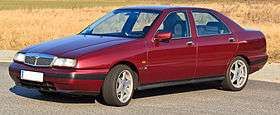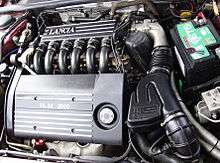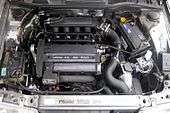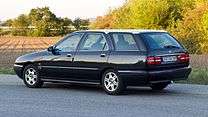Lancia Kappa
The Lancia Kappa (Type 838) is an executive car produced by Italian automaker Lancia. It replaced the Thema as Lancia's flagship model in 1994 and was itself replaced by Lancia Thesis in 2001. It shared its platform with the Alfa Romeo 166 and was available as a saloon, estate or coupé. The Kappa was only available in left-hand drive, as Lancia pulled out of right-hand drive markets after the demise of the Thema.
| Lancia Kappa | |
|---|---|
 | |
| Overview | |
| Manufacturer | Lancia |
| Also called | Lancia K |
| Production | 1994–2000 |
| Assembly | Saloon: Rivalta plant, Turin, Italy[1] Coupé: Chivasso, Italy (Maggiora)[2] Estate: Turin, Italy (Pininfarina)[3] |
| Designer | Ercole Spada at I.DE.A Institute (saloon) Centro Stile Lancia (Coupé) Pininfarina (Estate) |
| Body and chassis | |
| Class | Executive car (E) |
| Body style | 4-door saloon 5-door estate 2-door coupé |
| Layout | FF layout |
| Platform | Type E[4] |
| Related | Alfa Romeo 166 |
| Powertrain | |
| Engine | Petrol: 2.0 L turbocharged I4 2.0 L Fiat family C I5 2.0 L Fiat family C turbocharged I5 2.4 L I5 3.0 L Alfa Romeo V6 Diesel: 2.4 L Multijet turbodiesel I5 |
| Transmission | 5-speed manual 4-speed automatic[5] AISIN or Z.F. |
| Dimensions | |
| Wheelbase | Saloon/estate: 2,700 mm (110 in) Coupé: 2,580 mm (102 in)[6] |
| Length | Saloon/estate: 4,687 mm (184.5 in) Coupé: 4,567 mm (179.8 in)[6] |
| Width | Saloon/estate: 1,826 mm (71.9 in) Coupé: 1,830 mm (72 in)[6][7] |
| Height | Saloon/estate: 1,462 mm (57.6 in) Coupé: 1,425 mm (56.1 in)[6] |
| Curb weight | 1,425 kg (3,142 lb)-1,580 kg (3,483 lb)[5] |
| Chronology | |
| Predecessor | Lancia Thema |
| Successor | Lancia Thesis |
Overview

Kappa is the tenth letter of the Greek alphabet, Lancia nameplates having frequently derived from Greek letters. In 1919, Lancia had already produced a Kappa (and its later evolutions called Dikappa and Trikappa),[5] but these are far less known nowadays than the 1990s Kappa. In writing, Lancia often referred to the Kappa simply as the k (lower case "k"), which is fairly similar to the original Greek letter κ.
Kappa production reached 117,216,[8] with Italy remaining its most important market. In Poland, where Fiat Auto is the largest domestic car manufacturer, the Kappa served as official government cars (replacing Themas).[7]
Autocar's Peter Robinson reviewed the Kappa in November 1994.[9] He commented on the car's bland styling which was justified by Fiat's Paolo Cantarella on the basis that the designers did not want to create too much "visual noise." The body was reported as having twice the torsional rigidity of the outgoing Thema, and was 15 percent stiffer than any of its rivals. The automatic Aisin-Warner gearbox (50-40 LE type) was shared with the Volvo 850. Robinson went on to say "the Kappa´s dimensions ensure a commodious interior, the impression of space only heightened by a low cowl and very Japanese-looking fascia, somewhere between a Honda NSX and Lexus LS400." Rear cabin room was described as "immense" but the cushion was criticised for being too flat, a fault rectified in later iterations of the car. Robinson criticised the "horrid mock wood with which Lancia frames the prominent central console that runs from the handbrake, up the full length of the dash and over the top." About the driving characteristics, Robinson wrote: "If Lancia quietened the starter motor, this would be one refined drivetrain...with no hint of any 5-cylinder unevenness." The 2.4 litre engine tested appeared to have been tuned for low-end torque, a characteristic of this Alpine brand. The engine was praised by Robinson for its "smooth responsiveness" and "torque steer has been eliminated...and the Servotronic steering is terrific, with just the right degree of self-centering." His summary of ride and handling was that car was better than average but not class-leading: "On the Lancia there is too much body roll and the front grip in the wet didn't inspire confidence."
Model history
- 1994 - Kappa production begins.
- 1996 - An estate car joins the lineup. The naturally aspirated 2.0-litre gasoline engine is fitted with a variable geometry inlet manifold. Inside the cabin, the seats are replaced by a new design, including new upholstery patterns.
- 1997 - The coupé is launched, while at the same time, some changes are made to the interior, trunk, suspension and engine bay, as well as new alloy wheels.
- 1998 - The 2.0 L turbocharged four-cylinder engine gets replaced by the five-cylinder, while the turbodiesel was upgraded to a JTD engine. The bumper guards, previously black, are changed to body-coloured, and the base trim level, LE, is dropped, leaving only the more lavish LS and LX. At the same time, a special trim level is introduced for the turbocharged gasoline engine, called simply the "Turbo", distinguished by the lack of chrome decals around the window frames. The interior materials are also upgraded across the lineup, including the addition of a leather-wrapped steering wheel with a different design and front central armrest.
- 1999 - The other two five-cylinder engines are modified along with the air conditioning unit.
- 2000 - The Kappa gains xenon HID headlamps. Production ceased in mid-2000 (Coupé's earlier in the year).[5][7]
Kappa SW and Coupé
The station wagon version of the Kappa, designated "SW" by Lancia, was designed and built by Pininfarina and did not differ from the saloon exterior dimensions, sharing most of its body panels.[5] Only 9,208 cars were built in Pininfarina's factory.[3] This estate version was also available with Boge-Nivomat self-levelling hydropneumatic rear suspension.
The Coupé was designed by Centro Stile Lancia and built by Maggiora and technically quite different from the saloon, having a shorter wheelbase (by 120 mm),[10] wider rear track and a distinctive profile with frameless doors. The front, from bumper to the window screen, was identical to the other Kappas. It was Lancia's first coupé since 1984, when the Beta and Gamma coupés were discontinued, and remains the last Lancia to feature this body style to this day. The small building capacities at the Maggiora factory for this essentially hand-made car, and the relatively high price, destined it to be a rare vehicle. As a money saver the rear lights came from Delta. Only 3263 coupes were manufactured from 1996 to 2000, making this model a true rarity.[5] Car magazine[10] described the car as looking "top heavy, like a Bentley Continental that's been heated up and squeezed at both ends." However, the car's engine range was praised for matching the vehicle's dynamics, the 2.4 litre five cylinder and the 3.0 Alfa-derived V6 coming closest to "infusing the k Coupe with the classy character its styling tries to suggest."[10] "It's the spiky turbo four that asks the hardest questions of the chassis and the all-strut suspension doesn't flounder. It shines. A viscous coupling helps the front wheels cope with the onslaught of the engine's old school, big-bang turbo delivery, and it feels remarkably untroubled."[10] About the refinement and ride, John Barker (of Car Magazine) reported that the occupants "are completely isolated from any vibration while the ride is smooth at moderate speeds, parrying bumps quietly and unobtrusively."[10] The interior was described as "appealing" and having "curvy, attractive door casings, plump supportive Recaro seats and choice plastics.".[10] The 1997 price was estimated at 24,000 pounds sterling.[10]
Engines
The Kappa had engines fitted transversely, all powering only the front wheels. They were available with either a five-speed manual or four-speed automatic transmission, unless otherwise indicated.[5][7]
2.0 20V
- 1998 cc, straight-5, DOHC, 4 valves per cylinder, 146 PS (107 kW; 144 hp) @ 6100 rpm & 185 N⋅m (136 lb⋅ft) @ 4500 rpm
- 1998 cc, straight-5, DOHC, 4 valves per cylinder, 155 PS (114 kW; 153 hp) @ 6500 rpm & 186 N⋅m (137 lb⋅ft) @ 4000 rpm
- uprated to 155 PS in 1996, after the addition of a variable geometry inlet manifold, called the Variable Intake System (V.I.S) by Lancia
- modified again in 1999
- there were two versions of the manual transmission available for this engine, called Power Drive and Comfort Drive, with gear ratios optimized towards the former or the latter, respectively. Optional 4-speed automatic AISIN AW 596 could be chosen, later replaced by AW 30510.
- this engine was not available in the Coupé
2.4 20V
- 2446 cc, straight-5, DOHC, 4 valves per cylinder, 175 PS (129 kW; 173 hp) @ 6100 rpm & 230 N⋅m (170 lbf⋅ft) @ 3750 rpm
- fitted with V.I.S
- from 1998 available with 4-speed automatic AISIN AW 30510.
- slightly modified in 1999
3.0 V6 24V

- 2959 cc, 'Busso' V6, DOHC, 4 valves per cylinder, 204 PS (150 kW; 201 hp) @ 6300 rpm & 270 N⋅m (199 lbf⋅ft) @ 4500 rpm
- not fitted with V.I.S
- slightly modified in 1999
- Available with 5-speed manual transmission or 4-speed automatic Z.F. 4HP-18EH or from 1998 with Z.F. 4HP20. The latter marketed as sequential, adaptive automatic called 'Comfortronic', with manual operation.
2.0 16V Turbo

- 1995 cc, turbo straight-4, DOHC, 4 valves per cylinder, 205 PS (151 kW; 202 hp) @ 5600 rpm & 298 N⋅m (220 lb⋅ft) @ 2750 rpm
- superseded by the 5-cylinder turbo in 1998
- 5-speed manual transmission only
2.0 20V Turbo
- 1998 cc, turbo straight-5, DOHC, 4 valves per cylinder, 220 PS (160 kW; 220 hp) @ 6000 rpm & 315 N⋅m (232 lb⋅ft) @ 2750 rpm
- superseded the 4-cylinder turbo in 1998
- 5-speed manual transmission only
2.4 TDs/JTD
- originally a distributor-pump turbodiesel refitted with common rail in 1998 and hence referred to as JTD engine
- TDs - 2387 cc, turbodiesel straight-5, SOHC, 2 valves per cylinder, 124 PS (91 kW; 122 hp) @ 4250 rpm & 246 N⋅m (181 lb⋅ft) @ 2250 rpm
- JTD - 2387 cc common rail turbodiesel straight-5, SOHC, 2 valves per cylinder, 136 PS (100 kW; 134 hp) @ 4250 rpm & 309 N⋅m (228 lb⋅ft) @ 2000 rpm
- not available with automatic transmission or in the Coupé
| Engine | Displacement | Power | Torque | Body | Gearbox | Top speed | 0–100 km/h (0–62 mph) |
Year |
|---|---|---|---|---|---|---|---|---|
| Petrol engines | ||||||||
| 2.0 20V LE | 1,998 cc (121.9 cu in) | 146 PS (107 kW; 144 hp) @ 6100 rpm | 185 N⋅m (136 lb⋅ft) @ 4500 rpm | BN | manual automatic | 205 km/h (127 mph) - | 9.8 s - | 1994 |
| 2.0 20V | 1,998 cc (121.9 cu in) | 155 PS (114 kW; 153 hp) @ 6500 rpm | 186 N⋅m (137 lb⋅ft) @ 4000 rpm | BN | manual automatic | 212 km/h (132 mph) 210 km/h (130 mph) | 9.2 s 12.1 s | 1996 |
| SW | manual | 205 km/h (127 mph) | 10.0 s | 1996 | ||||
| 2.4 20V | 2,446 cc (149.3 cu in) | 175 PS (129 kW; 173 hp) @ 6100 rpm | 230 N⋅m (170 lbf⋅ft) @ 3750 rpm | BN | manual automatic | 218 km/h (135 mph) 215 km/h (134 mph) | 8.7 s 10,5 s | 1994 1998 |
| SW | manual automatic | 212 km/h (132 mph) 210 km/h (130 mph) | 8.9 s 10,7 s | 1996 1998 | ||||
| C | manual | 218 km/h (135 mph) | 8.7 s | 1996 | ||||
| 3.0 V6 24V | 2,959 cc (180.6 cu in) | 204 PS (150 kW; 201 hp) @ 6300 rpm | 270 N⋅m (199 lbf⋅ft) @ 4500 rpm | BN | manual automatic comfortronic | 225 km/h (140 mph) 220 km/h (137 mph) 220 km/h (137 mph) | 8.0 s 9.8 s - | 1994 1994 1998 |
| SW | automatic comfortronic | 218 km/h (135 mph) 218 km/h (135 mph) | 9.9 s - | 1996 1998 | ||||
| C | automatic comfortronic | 225 km/h (140 mph) 220 km/h (137 mph) | 9.8 s 8.9 s | 1996 1998 | ||||
| 2.0 16V turbo | 1,995 cc (121.7 cu in) | 205 PS (151 kW; 202 hp) @ 5600 rpm | 298 N⋅m (220 lb⋅ft) @ 2750 rpm | BN | manual | 235 km/h (146 mph) | 7.3 s | 1994 |
| SW | manual | 230 km/h (143 mph) | 8.3 s | 1996 | ||||
| C | manual | 235 km/h (146 mph) | 7.3 s | 1996 | ||||
| 2.0 20V turbo | 1,998 cc (121.9 cu in) | 220 PS (162 kW; 217 hp) @ 5750 rpm | 315 N⋅m (232 lb⋅ft) @ 2750 rpm | BN | manual | 243 km/h (151 mph) | 7.3 s | 1998 |
| SW | manual | 235 km/h (146 mph) | 7.9 s | 1998 | ||||
| C | manual | 243 km/h (151 mph) | 7.3 s | 1998 | ||||
| Diesel engines | ||||||||
| 2.4 10V td | 2,387 cc (145.7 cu in) | 124 PS (91 kW; 122 hp) @ 4000 rpm | 265 N⋅m (195 lb⋅ft) @ 2000 rpm | BN | manual | 193 km/h (120 mph) | 12.6 s | 1994 |
| SW | manual | 190 km/h (118 mph) | 11.5 s | 1996 | ||||
| 2.4 10V JTD | 2,387 cc (145.7 cu in) | 136 PS (100 kW; 134 hp) @ 4250 rpm | 309 N⋅m (228 lb⋅ft) @ 2000 rpm | BN | manual | 202 km/h (126 mph) | 10.0 s | 1998 |
| SW | manual | 200 km/h (124 mph) | 10.8 s | 1998 | ||||
BN-saloon, SW-station wagon, C-coupé; manual is 5-speed, automatic/comfortronic is 4-speed
Concept cars and specials
.jpg)
Lancia Kayak
The Lancia Kayak or Bertone Kayak was a 4-seater coupé concept car by Italian coachbuilder Bertone based on Lancia Kappa mechanicals, unveiled at the 1995 Geneva Motor Show.[11]
Kappa Limousine
A one-off Kappa Limousine with extended middle section, and wheelbase, was built for Gianni Agnelli. Its concept was very similar to the Thema Limousine from 1987. The car was finished in dark blue with a matte-black roof.

References
- "GUÍA EUROPEA DE CÓDIGOS DE PROYECTOS - 2001-" (PDF). autoindustria.com. Archived from the original (PDF) on 2007-09-30. Retrieved 2007-08-05.
- "M A G G I O R A". .fiatbarchetta.com. Retrieved 2007-08-05.
- "PRODUZIONE COMPLESSIVA" (PDF). pininfarina.it. Archived from the original (PDF) on 2011-06-05. Retrieved 2007-08-03.
- "Automotive Design and Production, Feb 2002, accessed via". Findarticles.com. Archived from the original on 2010-10-18. Retrieved 2010-09-30.
- CarsFromItaly.com Lancia Kappa page accessed via the Wayback Machine
- "Lancia specifications at". Carfolio.com. Retrieved 2010-09-30.
- Polish Lancia Kappa enthusiast page Archived 2006-04-24 at the Wayback Machine (in Polish)
- "Produzione complessiva modelli Lancia" (PDF). Retrieved 2010-09-30.
- Autocar, November 1994
- Car magazine, July 1997
- Ciferri, Luca (25 February 1995). "Viva le mini—Spider, Ginevra promette". La Repubblica (in Italian). Retrieved 1 June 2015.


